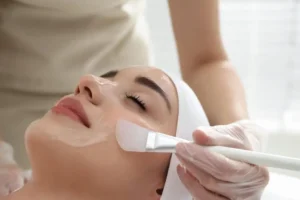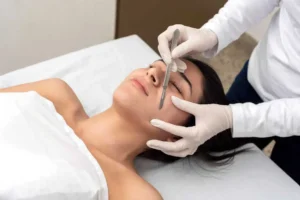
Introduction
Are you looking to rejuvenate your skin and address specific concerns? Chemical peels treatment in Chandler, AZ, might be your solution. At Opulent Aura Aesthetics LLC, we offer tailored peel treatments for smoother, more radiant skin. This guide’ll explore how chemical peels work for various skin types and concerns, helping you find the perfect treatment for your unique needs.
What Are Chemical Peels?
Chemical peels are specialized skincare treatments designed to improve skin texture and overall appearance. The procedure involves applying a carefully formulated solution to your skin, which gently exfoliates and removes damaged upper layers. This process reveals fresher, healthier skin underneath, typically resulting in a smoother, less wrinkled appearance with reduced signs of damage.
How Do Chemical Peels Work?
The magic of chemical peels lies in their ability to treat a variety of skin concerns, including:
- Acne scars
- Sun damage
- Hyperpigmentation
- Uneven texture or tone
- Wrinkles and fine lines
- Skin dryness
Depending on the peel’s strength and depth, different skin penetration levels can be achieved. These range from light (superficial) to deep peels, allowing customized treatments based on your specific needs and skin type.
Types of Chemical Peels
1. Superficial Peels
Superficial peels, also known as light peels, are the gentlest option. They typically use mild acids like alpha-hydroxy acids (AHAs) to exfoliate the outermost layer of the skin. These peels are excellent for:
- Mild skin discoloration
- Rough skin texture
- Refreshing overall skin appearance
The superficial peels require little to no downtime and are suitable for all skin types, making them a popular choice for first-time peel users or those with sensitive skin.
2. Medium Peels
Peels of medium depth penetrate deeper into the skin, targeting the upper part of the middle skin layer. They often use higher concentrations of trichloroacetic acid (TCA) or glycolic acid. Medium peels are effective for:
- Moderate sun damage
- Fine lines and wrinkles
- Uneven skin tone
- Mild to moderate acne scars
These peels typically require some downtime for healing, usually a few days to a week.
3. Deep Peels
Deep chemical peels reach the lower dermal layers, providing the most dramatic results. They often use phenol or high-concentration TCA. Deep peels are reserved for:
- Severe sun damage
- Deep wrinkles
- Significant hyperpigmentation
- Severe acne scarring
Due to their intensity, deep peels require significant downtime and are usually performed only once. They’re unsuitable for all skin types and should only be administered by experienced professionals.
Chemical Peels for Acne: A Game-Changer for Clear Skin
One of the most popular applications of chemical peels is in treating acne and acne scars. Here’s how chemical peels can help:
- Exfoliation: Peels remove dead skin cells that can clog pores and lead to breakouts.
- Oil control: Some peels can help regulate sebum production, reducing oiliness.
- Bacteria reduction: Certain peel solutions have antibacterial properties, helping to combat acne-causing bacteria.
- Scar improvement: Regular treatments can gradually improve the appearance of acne scars.
For those struggling with persistent acne, a series of chemical peel treatments can be a highly effective part of a comprehensive skincare regimen.
The Chemical Peel Benefits You Can Expect
When you choose to undergo a chemical peel treatment, you invest in your skin’s health and appearance. Some of the key benefits include:
- Improved skin texture and tone
- Reduced appearance of fine lines and wrinkles
- Brighter, more radiant complexion
- Clearer skin with fewer breakouts (for acne-prone individuals)
- More even skin tone and reduced hyperpigmentation
- Boosted collagen production for firmer, more youthful-looking skin
Chemical Peel for Dark Spots: A Targeted Approach
Hyperpigmentation and dark spots can be challenging to treat, but chemical peels are effective. Here’s how they work on dark spots:
- Exfoliation of pigmented cells: Peels remove the top layer of skin, which often contains the darkest pigmented cells.
- Inhibition of melanin production: Some peel solutions can help slow down melanin production, the pigment responsible for dark spots.
- Increased cell turnover: By promoting faster skin cell renewal, peels help quickly fade dark spots.
For best results, a series of treatments and a good at-home skincare routine are usually recommended, including sun protection.
What to Expect: Chemical Peel Before and After
Understanding the chemical peel process can help set realistic expectations for your treatment:
Before the Peel
- Consultation: Your practitioner will assess your skin and discuss your goals to determine the best type of peel for you.
- Preparation: You may be advised to discontinue certain skincare products or medications before treatment.
- Skin cleansing: Your skin will be thoroughly cleansed before the peel application.
During the Peel
- Application: The peel solution is carefully applied to your skin.
- Sensation: You may feel a slight tingling or warming sensation, which is normal.
- Timing: Depending on the type of peel, the solution is left on for a predetermined amount of time.
After the Peel
- Immediate effects: Your skin may appear red and sensitive, similar to a mild sunburn.
- Peeling: Depending on the peel depth, you may experience visible peeling for a few days.
- Results: Initial improvements can be seen within a few days, with full results appearing after 1-2 weeks.
Following your practitioner’s post-treatment care instructions carefully is crucial to ensure the best possible results and minimize any potential side effects.
How to Choose the Right Chemical Peel for Your Skin
Selecting the appropriate chemical peel depends on various factors, including skin type, concerns, and treatment goals. Here’s a general guide:
- Sensitive skin: Opt for gentler, superficial peels with lactic acid or low-concentration glycolic acid.
- Oily or acne-prone skin: Medium-strength salicylic acid or glycolic acid peels can be beneficial.
- Dry or mature skin: AHA or TCA peels can help improve hydration and address fine lines.
- Hyperpigmented skin: Consider peels with kojic acid, azelaic acid, or low-concentration TCA.
Consult a skin care professional before choosing the most suitable peel for your unique skin needs.
Conclusion: Transform Your Skin with Chemical Peels
Chemical peels offer a versatile and effective solution for many skin concerns, from acne and dark spots to fine lines and uneven texture. You can improve your skin’s health and appearance by choosing the right type of peel for your skin type and concerns.
At Opulent Aura Aesthetics LLC, we’re dedicated to helping you achieve your skincare goals through chemical peel treatments. Our experienced practitioners will work with you to develop a treatment plan tailored to your unique needs and skin type.
Ready to reveal your most radiant skin? Schedule a consultation today to learn more about our chemical peel treatment in Chandler, AZ. Let us help you unlock your skin’s potential and boost your confidence with a refreshed, glowing complexion.





